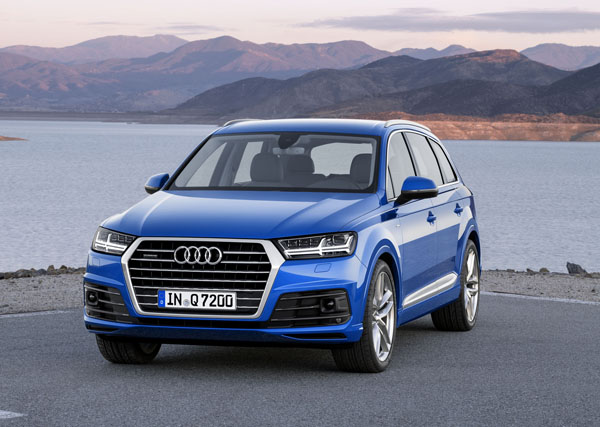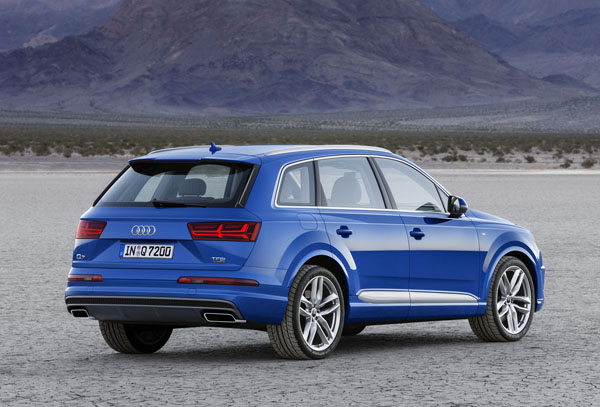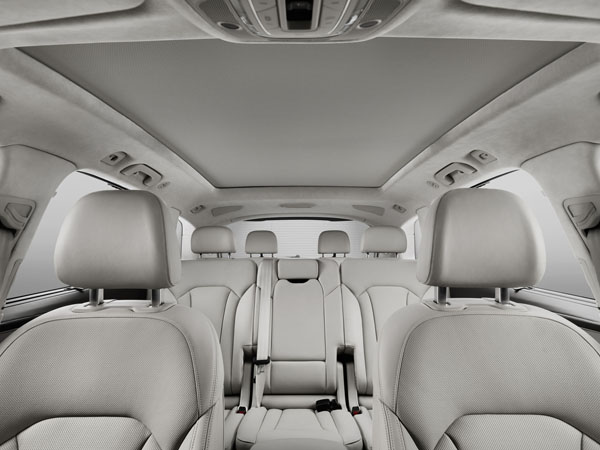
By EWAN KENNEDY in Sion, Switzerland
The all-new second-generation Audi Q7 has been a long time coming – but it has most certainty been worth the wait. The automotive world has changed out of sight in the nine years since we were taken by surprise by the large Q7 SUV from the people at Ingolstadt. A vehicle that set new standards for comfortable passenger transport and ease of driving at the time.
The upmarket German marque has long been famed for technology, indeed its slogan ‘Vorsprung durch Technik’ translates approximately into English as ‘Advancement through Technology’. So it comes as no surprise the new Q7 is crammed with the latest technology, not only in the infotainment department, but also in body, powertrain and suspension.
For a start, up to 325 kg has been trimmed from weight when compared to the 2006 original. An impressive result that gives it better performance while using less fuel and creating significantly less air pollution.
Styling could be on the controversial side as the new Q7 has a shape that falls roughly midway between SUV and Avant station wagon. This is important in Europe as public opinion is often against overtly large 4WD vehicles. On the other hand Australians do like their SUVs to have a big, bold shape. Perhaps the sophisticated image of Audi downunder will stand it in good stead.
At the front there’s the boldest iteration to date of the Audi ‘single-grille’ theme. Tied in with the slim headlights and large foglight housings new Q7 certainly stands out, with a sharp appearance that caused many to look at our vehicles during the two-day test driving program.
Interior room in this big Audi is pretty impressive, being even more than before. Those looking for a stylish people mover should have Q7 sitting high in their short list.
The front seats are large, well shaped and comfortable and provided good support during our trips over many a long and winding in the ski fields of the Sion area in Switzerland, the area chosen by Audi for the Q7’s global launch. (Sepp Blatter, of FIFA fame was out of town on other business at the time, but calls this area home.)
Audi has gained a lead on the opposition by fitting a four-wheel steering system. This active unit has the rear wheels turning for improved cornering grip and greater stability in cross winds at cruising speeds. At the other end of the scale, the turning circle has been reduced by almost a metre to make parking simpler.
A large German SUV that’s nimble in bends and easy to manoeuvre in tight spots around town, what more could you ask?
The second row seats can be adjusted back and forward, in their rearmost position to provide plenty of legroom for three. The pair of third row seats has good space for children, though adults will feel squeezed in. Rows two and three fold flat to provide a huge load area.
The doors are larger than before and open wider to provide easier access to the rearmost seats. With all seats in use luggage space is relatively limited, but we have seen worse.
Though the new Audi Q7 is also offered with five seats, it is unlikely to be imported to Australia. That’s because only a very small number of buyers opted for the five-seater in the about to be superseded first generation model.
An instrument layout that’s fully electronic, though still looking relatively conventional, gives clear readings in all lighting conditions as it can adapt to remove, or at least minimise glare; an excellent feature for Australian conditions.
Power for Australian imports comes from a pair of turbo-diesels, both V6s with displacement of 3.0 litres. Though based on previous units already familiar to Audi drivers they have received so many changes they can be classed as virtually new. One manages a hefty 200 kilowatts of power and an impressive 600 Nm of torque, the latter from 1500 to 3000 rpm. The other gives 160 kW and 500 Nm from 1250 to 3000 revs.
We test drove both engines extensively and found that the 160 kW probably has enough performance for many buyers. Then again, Audi owners worldwide aren’t exactly know for their light-footed approach to motoring and may import only the 200 kW machine.
Transmission is by eight-speed ZF automatic to all four wheels using the latest version of Audi’s quattro system.
Other powerplants are offered in different markets, including a 245 kW supercharged petrol engine, but the Australian importer feels local buyers in this crossover SUV class have a strong preference for diesels so it’s unlikely petrols will come here.
What is almost certainly coming downunder is the diesel-electric hybrid version, called e-torn in Audi speak. This plug-in hybrid has a range of about 50 kilometres so commuting drivers will often have no reason to call the diesel engine into play.
Safety sees the installation of eight airbags in a strong body built from an array of steels as well as aluminium.
New Audi Q7 won’t go on sale until until September this year and will have a recommended retail price of $103,900 plus on-road costs. If the 160 kW variant does come it would presumably have a price a little under the $100K mark.













